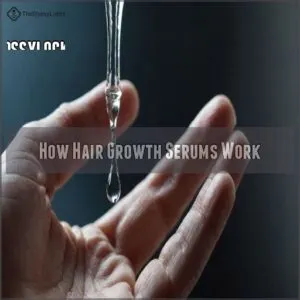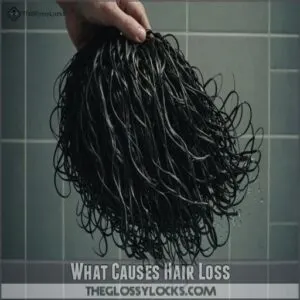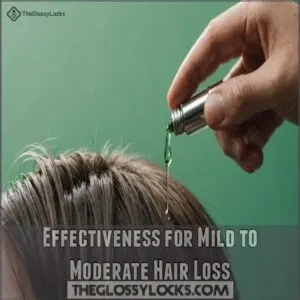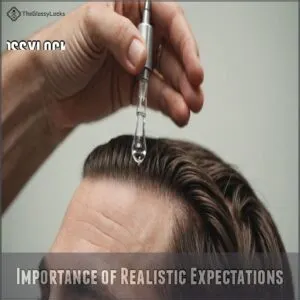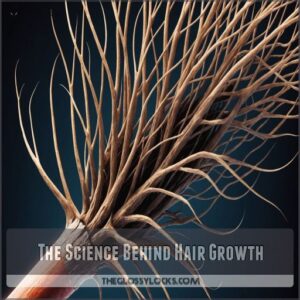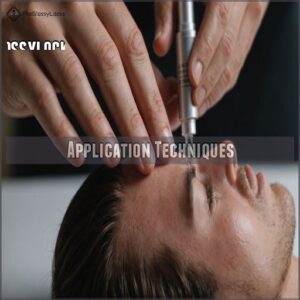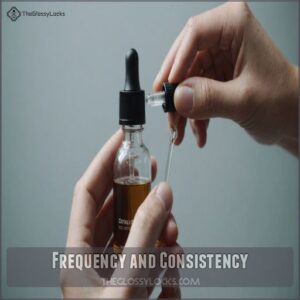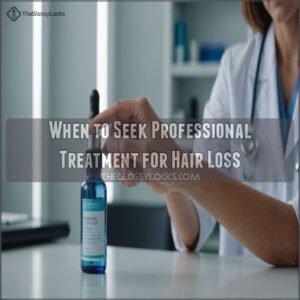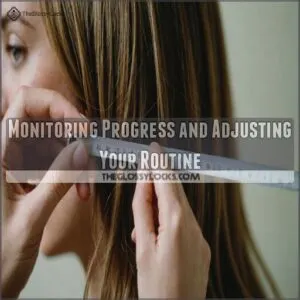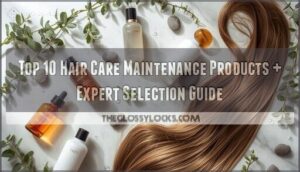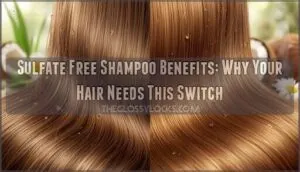This site is supported by our readers. We may earn a commission, at no cost to you, if you purchase through links.

Well, they can be effective for mild to moderate hair thinning.
Ingredients like Minoxidil, biotin, and caffeine work to strengthen strands and improve thickness.
Imagine your hair growth efforts aided by these tiny heroes!
But, and it’s a big but, they might not reverse advanced hair loss or grant you Rapunzel-length hair overnight.
It’s essential to set realistic expectations.
While serums add shine and health, think of them as a supporting act, not the main event.
Ready for more secrets to hair happiness?
Stay tuned for expert tips!
Table Of Contents
- Key Takeaways
- How Hair Growth Serums Work
- What Causes Hair Loss
- Are Hair Growth Serums Effective
- How to Choose a Hair Growth Serum
- The Science Behind Hair Growth
- How to Use Hair Growth Serums for Best Results
- Lifestyle Changes to Support Hair Health
- When to Seek Professional Treatment for Hair Loss
- Monitoring Progress and Adjusting Your Routine
- Frequently Asked Questions (FAQs)
- Does a hair growth serum really work?
- What is a hair growth serum?
- How do I choose the best hair growth serum?
- Can a hair growth serum help thinning hair?
- Do hair growth serums really work?
- Can hair growth serum regrow hair?
- What are the disadvantages of using hair growth serum?
- Is it worth using hair serum?
- Can hair growth serums be used with other products?
- Are hair growth serum ingredients safe during pregnancy?
- How long should I use a serum before switching?
- Do serums work the same for all hair types?
- Can hair growth serums cause any side effects?
- Conclusion
Key Takeaways
- You’ll find hair growth serums can effectively tackle mild to moderate thinning, with promising results from ingredients like minoxidil and biotin over a few months.
- Patience is key, as these serums aren’t overnight solutions; expect to see noticeable improvements only after consistent application for 3-6 months.
- Check ingredient lists for specifics like minoxidil or natural extracts, and match them to your hair type for the best results.
- Set realistic expectations, as serums can’t revive dead follicles or reverse advanced hair loss, which may require professional treatment.
How Hair Growth Serums Work
You can also promote hair growth by protecting your hair from breakage with methods like braiding for hair protection. You’ll find that hair growth serums work by delivering active ingredients like minoxidil, biotin, and caffeine directly to your hair follicles to promote growth and thickness.
Your scalp absorbs these powerful compounds, which then stimulate blood flow and provide essential nutrients to wake up dormant follicles and strengthen existing hair.
Ingredients for Hair Growth
While your journey to thicker hair might seem challenging, understanding the right ingredients can make all the difference.
Natural extracts like rosemary oil and pumpkin seed extract work to stimulate your follicles, while peptides help strengthen existing strands.
For best growth, many people turn to products with proven hair growth serum results (hair growth serum results).
Plant-based compounds such as aloe vera and ginseng soothe your scalp, creating the perfect environment for healthy growth.
Each ingredient plays its unique role in transforming your hair.
Role of Minoxidil, Biotin, and Caffeine
The powerhouse trio of minoxidil, biotin, and caffeine works together to give your hair the boost it needs.
These ingredients have shown promising results in clinical studies, each playing a unique role in hair growth:
- Minoxidil increases blood flow to follicles and extends the growth phase
- Biotin strengthens hair structure and prevents breakage
- Caffeine blocks DHT and stimulates follicle production
Remember, you’ll need patience – results typically take 3-6 months to show.
Benefits of Natural Ingredients
Natural ingredients, like those found in a well-balanced diet rich in essential nutrients such as vitamins A, C, E, B-complexes, folic acid, zinc, selenium, and biotin promoting hair growth, offer a gentler path to hair growth compared to synthetic compounds.
Plant-based solutions like rosemary oil can match minoxidil’s effectiveness, while pumpkin seed oil boosts hair count by up to 40%.
You’ll find aloe vera soothes your scalp, and green tea extract fights DHT buildup.
These sustainable options work with your body’s natural processes, often with fewer side effects than chemical alternatives.
What Causes Hair Loss
You’re not alone if you’ve noticed more hair in your brush lately, as a whopping 80% of men and 50% of women face hair loss at some point in their lives.
The mix of genetic factors, hormonal changes, and everyday stress can turn your once-thick locks into a source of worry, but understanding these causes is your first step toward finding the right solution.
Genetics and Hormones
Understanding how hair growth serums work leads us to a key culprit behind hair loss: your genetic blueprint.
If you’ve noticed thinning hair and your family photo album shows similar patterns, you’re likely dealing with hereditary hair loss.
Hormonal imbalances, especially changes in testosterone and DHT levels, can trigger hair follicles to shrink.
Your genes and hormones work together, often determining your hair’s destiny.
Lifestyle Factors and Stress
While genetics play a major role, your daily habits directly impact hair health too.
Stress hits your body like a wrecking ball, and your hair’s often the first to show it.
Here’s what’s likely stressing out your strands:
- Poor sleep throws off your body’s repair cycle
- Crash diets rob your hair of essential nutrients
- High-stress levels spike cortisol, weakening hair follicles
Are Hair Growth Serums Effective
You’ll be glad to know that hair growth serums can effectively combat mild to moderate hair thinning, with scientific studies showing promising results for ingredients like minoxidil and biotin.
While they won’t work miracles on advanced hair loss, you’ll typically see noticeable improvements in hair thickness and density after a few months of consistent use.
Effectiveness for Mild to Moderate Hair Loss
If you’re dealing with mild to moderate hair thinning, hair growth serums can be your secret weapon.
Real-world studies show success rates of 60-80% for early-stage hair loss when used consistently.
Your results will vary based on factors like genetics and lifestyle, but most users see noticeable improvement within 3-6 months.
The key? Stick to your routine – these aren’t overnight miracle workers.
Limitations for Advanced Hair Loss
Hair growth serums can be effective for certain types of hair loss, such as female hair growth supplements, but they lose their effectiveness in cases of advanced hair loss, where follicles have become permanently damaged or scarred.
For severe thinning or baldness, these products can’t revive dead follicles or create new ones.
Think of it like trying to water a plant that’s already withered – sometimes you need a fresh start.
Importance of Realistic Expectations
Through your hair loss journey, it’s important to set realistic expectations about hair growth serums.
You won’t wake up with a full head of hair overnight – these products typically take 3-6 months to show results.
Everyone’s response varies based on genetics, age, and the extent of hair loss.
Think of it like growing a garden: patience is key, and consistent care yields the best results.
How to Choose a Hair Growth Serum
You’ll need more than just clever marketing to find a hair growth serum that actually works for your unique needs and hair type.
Whether you’re dealing with a sensitive scalp or looking for specific ingredients like minoxidil or biotin, we’ll help you navigate the science-backed options that can make a real difference in your hair growth journey.
Ingredients to Look For
Choosing the right ingredients in your hair growth serum can make all the difference.
Look for proven performers like minoxidil (the only FDA-approved ingredient), biotin for strength, and caffeine to stimulate follicles.
Natural ingredients like rosemary oil and pumpkin seed extract have shown promising results in studies.
For sensitive scalps, opt for serums with soothing components like aloe vera and chamomile.
Application Type and Frequency
Now that you’ve got your perfect serum, let’s talk about using it right. You’ll want to apply it directly to your scalp, not your hair strands. Think of it like watering a plant – you’re feeding the roots, not the leaves.
- Start with clean, towel-dried hair for maximum absorption
- Part your hair into sections to reach your entire scalp
- Use gentle, circular motions with your fingertips
- Apply consistently at the same time each day
- Let it absorb for 2-3 minutes before styling
Considerations for Sensitive Scalp or Hair Type
If you’ve got a sensitive scalp or particular hair type, you’ll need to be extra careful with your serum selection.
Look for products specifically formulated with gentle ingredients like aloe vera or chamomile.
Vegamour GRO Hair Serum works well for sensitive scalps, while Isdin Lambdapil suits fine hair types.
Always do a patch test before full application to avoid potential irritation.
The Science Behind Hair Growth
Understanding the different stages of the hair growth cycle, such as the anagen phase growth, can help you appreciate your hair’s natural process. You’ll be amazed to learn that your hair grows with distinct phases, just like the seasons of the year.
Your hair growth serums work by targeting specific points in this cycle, helping to extend the active growth phase while providing the essential nutrients your follicles need to thrive.
Hair Growth Cycle
Your hair’s life follows a fascinating three-act play.
During anagen (2-7 years), it’s actively growing about half an inch monthly.
Then comes catagen, a brief two-week intermission where growth stops.
Finally, in telogen (2-4 months), your hair takes a much-needed break before naturally falling out.
Understanding these phases helps you track your hair’s journey and spot potential issues early.
Role of Serums in Hair Growth
Hair growth serums work by delivering concentrated nutrients directly to your scalp and follicles.
Think of them as a targeted delivery system that bypasses the usual barriers.
They’re designed to penetrate deeply, stimulating blood flow and nourishing the hair roots where they’re needed most.
While using a treatment like rice water for hair growth can strengthen hair roots and aid in hair regeneration, there’s no magic bullet, consistent serum application can support your hair’s natural growth cycle and improve overall scalp health.
Impact of Ingredients on Hair Follicles
Through the microscopic world of your scalp, key ingredients in hair serums work like tiny gardeners tending to each follicle.
Minoxidil helps widen blood vessels, feeding your follicles with extra nutrients.
Biotin strengthens the protein structure, and caffeine blocks DHT, a hormone linked to hair loss.
Natural ingredients like rosemary oil and pumpkin seed extract provide additional support by reducing inflammation and promoting circulation.
How to Use Hair Growth Serums for Best Results
You’ll get the most out of your hair growth serum by mastering the right application techniques and sticking to a consistent routine.
While there’s no magic wand for instant results, following expert-backed methods can help you maximize the serum’s effectiveness and achieve thicker, fuller hair over time.
Application Techniques
Applying growth serums correctly makes all the difference in your results.
Start with a clean, damp scalp and use the dropper to apply small dots about half an inch apart.
You can check out best hair serum application techniques for more specific tips on how to use different types of serums.
Gently massage each section using circular motions with your fingertips or a scalp massager.
Don’t oversaturate – about 1ml of product is usually enough to cover your entire scalp without waste.
Frequency and Consistency
Once you’ve mastered the right application method, staying consistent is your next big win.
Most hair growth serums need daily use for the first few months, then you can scale back to 2-3 times weekly for maintenance.
Applying hair serum directly to the scalp can make your hair look greasy, so it’s best to apply it after towel-drying hair and before styling.
Your morning or evening routine works best – just pick a time you’ll remember.
Studies show users who stick to a regular schedule see up to 43% better results.
Lifestyle Changes to Support Hair Health
While you’re waiting for your hair growth serum to work its magic, you can boost its effectiveness with simple lifestyle tweaks that’ll make a real difference.
Your daily choices, from what’s on your plate to incorporating natural henna treatments like mehndi for hair growth, work together with your serum to give your hair the best chance at healthy growth.
Diet and Nutrition
Your hair’s health starts in your kitchen.
While you’re applying those serums, power up your results with foods rich in biotin, iron, and omega-3s.
Load up on eggs, salmon, nuts, and leafy greens – they’re like nature’s hair growth supplements.
Don’t forget vitamin D and zinc-packed foods.
And here’s a tip: taking a collagen supplement might give your hair an extra boost.
Exercise and Stress Reduction
Regular exercise boosts blood circulation to your scalp, delivering essential nutrients to hair follicles.
Try stress-free workouts like yoga or gentle jogging – they’ll help lower cortisol levels that can trigger hair loss.
Incorporating specific yoga asanas like inverted poses for hair growth can increase blood flow to the scalp, potentially promoting hair growth.
Even a 10-minute meditation session can work wonders.
Think of it like giving your hair follicles a mini-vacation from stress.
Remember, a calm mind often leads to healthier hair growth.
Avoiding Harsh Chemicals and Heat Styling
While you’re working on managing stress, let’s talk about protecting your hair from damage.
Think of your hair like a delicate silk scarf – it needs gentle handling to stay beautiful.
Heat styling and harsh chemicals can undo all the good work of your growth serum.
- Switch to heatless styling methods like overnight braids or silk rollers
- Choose sulfate-free, natural hair products
- Skip chemical treatments during your hair growth journey
When to Seek Professional Treatment for Hair Loss
If you’re losing more than 100 hairs a day or noticing bald patches that aren’t responding to over-the-counter treatments, it’s time to call in the pros.
While certain natural remedies like Ashwagandha, which may help stimulate keratin production for hair growth and thickness, can work wonders for mild thinning, a dermatologist or trichologist can identify the root cause of your hair loss and create a personalized treatment plan that actually works for you.
Consulting a Dermatologist or Hair Specialist
Consulting a hair specialist early can prevent minor hair concerns from becoming major headaches.
Here’s when to book that appointment:
| Warning Sign | When to Act |
|---|---|
| Sudden Loss | Within 2 weeks of noticing |
| Patchy Areas | First sign of circular patches |
| Scalp Issues | If itching persists 1+ week |
| Family History | Before visible thinning starts |
Don’t wait until you’re shedding a lot – early intervention makes all the difference in treatment success.
Advanced Hair Loss Treatment Options
If your hair serum isn’t delivering results, don’t lose hope.
Advanced treatments like hair transplants and laser therapy can be game-changers.
Your doctor might recommend FDA-approved medications or platelet-rich plasma therapy, which uses your own blood cells to jumpstart growth.
Some folks combine these with specialized hair growth supplements for a multi-angle approach.
These options pack more punch than over-the-counter solutions.
Importance of Early Intervention
Don’t wait until you’re losing clumps of hair to take action.
Like catching a cold early, addressing hair loss at the first signs gives you the best shot at keeping your locks.
You’ll notice early warning signs like more hair in your brush, a wider part, or thinning at the temples.
Getting professional help right away can prevent minor issues from becoming major headaches down the road.
Monitoring Progress and Adjusting Your Routine
You’re on the journey to luscious locks, but measuring your progress and tweaking your routine can make all the difference.
Keep track of growth and density changes, and don’t hesitate to switch up ingredients or combine serums with other strategies if needed—because who said hair care couldn’t be a little science experiment?
Measuring Hair Growth and Density
Tracking your hair’s progress can feel like watching grass grow, but it’s important for adjusting your routine.
For a more informed approach, consider reading reviews of various hair growth serums online, such as those found in hair growth serum reviews.
Try these methods:
- Visual Assessment: Snap monthly photos from the same angle.
- At-Home Options: Use apps that measure hair thickness.
- Density Measurement: Part your hair and count follicles.
- Professional Methods: Consult dermatologists for advanced tools.
Balancing patience with curiosity helps reveal tangible results.
Adjusting Serum Application or Ingredients
Adjusting your serum application or ingredients can be like finding the perfect coffee brew—everyone’s ideal mix and method vary.
When fine-tuning your routine, consider how hair growth serums work by stimulating dormant hair follicles, promoting hair growth.
Evaluate your serum frequency and ingredient ratios for the best results.
Pay attention to scalp sensitivity and experiment with different product combinations and application techniques.
Keep track, adapt, and find what suits your hair’s needs best, ensuring a smoother journey to healthier hair.
Combining With Other Hair Growth Strategies
So, you’ve tweaked your serum routine? Great! Now, let’s supercharge your hair growth. Think of it like this: you’re building a strong foundation. Here’s how to boost those results:
- Regular scalp massage improves blood flow.
- A balanced diet fuels hair growth.
- Exercise reduces stress, a major hair loss culprit.
- A gentle hair care routine minimizes damage.
These additions, alongside your serum, could be your winning combo!
Frequently Asked Questions (FAQs)
Does a hair growth serum really work?
Ever wondered if hair growth serums can work wonders?
They can be effective for mild to moderate thinning, using ingredients like minoxidil and biotin.
It’s important to have patience and consult a dermatologist for personalized advice.
What is a hair growth serum?
Hair growth serums are like a magic potion for your scalp, packed with ingredients like minoxidil and biotin.
They promote hair thickness and density over time, but patience is key—results don’t appear overnight!
How do I choose the best hair growth serum?
Pick the best hair growth serum by considering ingredients like minoxidil or biotin, your hair type, and specific goals.
Consult experts if unsure.
Read reviews for effectiveness, and be patient; visible results take time.
Can a hair growth serum help thinning hair?
Hair growth serums can boost the appearance of thinning hair by promoting thickness and fullness.
They won’t fix severe hair loss but can help stabilize mild to moderate thinning.
Try one and see what happens!
Do hair growth serums really work?
Rome wasn’t built in a day," and neither is a full head of hair. Many find serums helpful, boosting growth, but results vary. Patience and realistic expectations are key.
Can hair growth serum regrow hair?
Hair growth serums can’t magically regrow hair from dead follicles, but they can help thicken existing hair and slow further loss.
Think of them as reinforcements, not miracle workers, in your battle against thinning hair.
What are the disadvantages of using hair growth serum?
Using hair growth serums can irritate your scalp, make hair greasy, or lead to inconsistent results.
Some contain strong chemicals that aren’t suitable for everyone, especially if you have sensitivity issues or underlying scalp conditions.
Is it worth using hair serum?
Throwing caution to the wind, using a hair serum can be worth it if you’re aiming to boost hair thickness and shine.
It’s effective with consistent use, patience is key—think of it as a marathon, not a sprint.
Can hair growth serums be used with other products?
You can use hair growth serums with other hair care products, but it’s best to check for compatibility.
Mixing may affect effectiveness: consult a dermatologist if unsure.
Always follow the product instructions for the best results.
Are hair growth serum ingredients safe during pregnancy?
Pregnancy calls for caution, as some hair growth serum ingredients like minoxidil mightn’t be safe.
Always chat with your doctor first, ensuring both you and your baby stay safe while keeping your hair goals in check.
How long should I use a serum before switching?
Using a serum feels like the longest six months of your life before seeing results.
Give it that time consistently.
If nothing changes, it might be time to chat with a specialist about switching products.
Do serums work the same for all hair types?
Nope, hair type matters! A serum great for fine hair might weigh down thick hair. Find one designed for your needs—it’s all about the right fit for your locks.
Can hair growth serums cause any side effects?
Sure, hair growth serums can cause side effects like scalp irritation, redness, or itching.
It’s a bit like trying a new face cream—everyone’s skin reacts differently.
Always do a patch test first to be safe.
Conclusion
Did you know 50% of us will experience hair thinning?
While hair growth serums, packed with ingredients like Minoxidil and biotin, hold promise, they’re no magic wand.
They’re most effective for mild to moderate hair thinning, bolstering your efforts with some added shine.
But if you’re facing more severe hair loss, it’s wise to set realistic goals and consider professional advice.
With serums and a healthy lifestyle, you’ve got allies on your hair health journey.

